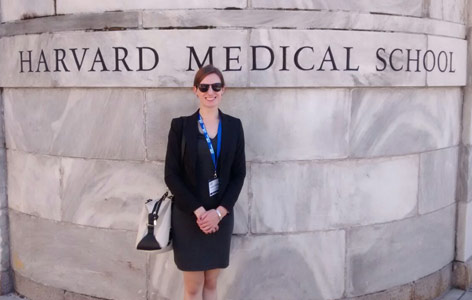Home page Description:
Society for Biomolecular Imaging & Informatics: High Content 2016 talks imaging in 3D cultures.
Posted On: October 21, 2016

Image Caption:
Conference attendee, Ashley Hickman, PhD Candidate.
Supervisors: Drs. David Andrews and Linda Penn, PM
Conference Highlight: Major areas of focus of the conference were the benefits and drawbacks of high-content screening in 3D cultures, and whether it is necessary for exploring most hypotheses.
Conference Article: Some of the most interesting work in the world of high-content screening today is focused on 3-D cultures, and high-content imaging of those cultures. 3D culture conditions are believed to better mimic the conditions found in vivo without having to move to mouse models. Many advances have been made with specialized plates and microscopes, but there is also a certain degree of pushback on whether IC50s measured in 3D vs 2D assays are any more relevant to a patient’s outcome. Within this area, there was also discussion on the best mode of image analysis. Is it better to collapse all of the z-stack planes to view a 2-D image of the spheroid? Or to collect volumetric assessments of the spheroid as a whole and consider its morphology and characteristics in that 3D form? While there is still no consensus, many agree that it may come down to the question being asked.
Another fascinating avenue of research is the use of deep learning to find patterns that correlate to biological information in images. Deep learning is a branch of machine learning that allows for intensive analysis of very large bodies of data. One group led by Dr. Hennig is taking brightfield and darkfield images (no stains, dyes or fluorescent markers) of cells in a flow cytometer, and then determining which phase of the cell cycle that a cell is in based solely on those two images. The same technique is also being used to accurately predict the DNA content of the cells! Deep learning has also facilitated the identification of neurons on a plate of astrocytes through brightfield imaging alone, something that is all but impossible for the human eye.
Conference Article: Some of the most interesting work in the world of high-content screening today is focused on 3-D cultures, and high-content imaging of those cultures. 3D culture conditions are believed to better mimic the conditions found in vivo without having to move to mouse models. Many advances have been made with specialized plates and microscopes, but there is also a certain degree of pushback on whether IC50s measured in 3D vs 2D assays are any more relevant to a patient’s outcome. Within this area, there was also discussion on the best mode of image analysis. Is it better to collapse all of the z-stack planes to view a 2-D image of the spheroid? Or to collect volumetric assessments of the spheroid as a whole and consider its morphology and characteristics in that 3D form? While there is still no consensus, many agree that it may come down to the question being asked.
Another fascinating avenue of research is the use of deep learning to find patterns that correlate to biological information in images. Deep learning is a branch of machine learning that allows for intensive analysis of very large bodies of data. One group led by Dr. Hennig is taking brightfield and darkfield images (no stains, dyes or fluorescent markers) of cells in a flow cytometer, and then determining which phase of the cell cycle that a cell is in based solely on those two images. The same technique is also being used to accurately predict the DNA content of the cells! Deep learning has also facilitated the identification of neurons on a plate of astrocytes through brightfield imaging alone, something that is all but impossible for the human eye.




